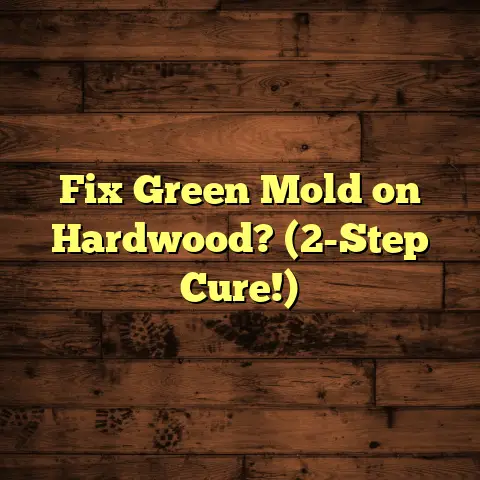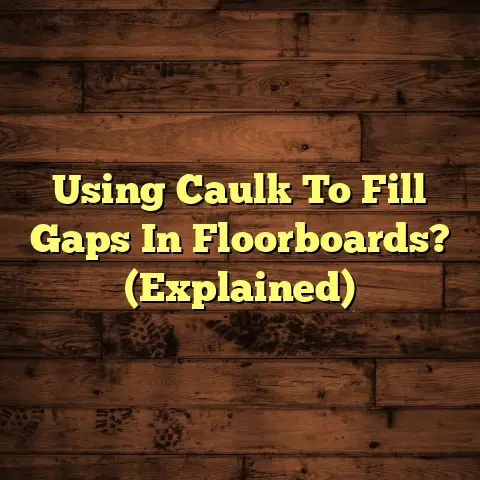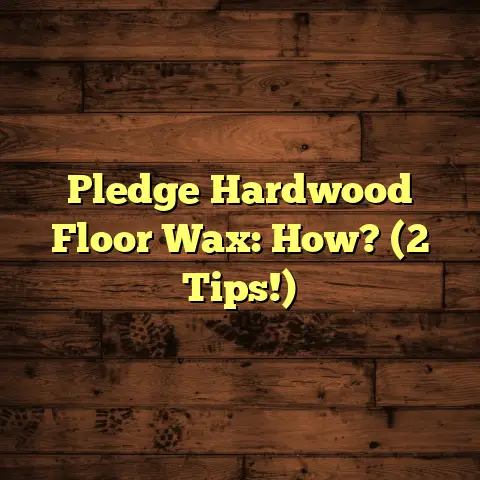How To Stop Squeaky Plywood Floors? (Explained)
Have you ever walked across a plywood floor and felt like you were auditioning for a horror movie with all the creaks and squeaks?
It’s frustrating, right?
I remember the first time I encountered this issue in my own home.
Every step I took felt like a loud announcement, waking up everyone in the house.
It made me wonder how I could enjoy my living space when each movement echoed through the floor.
Identifying the Source of Squeaks
When I first tackled the problem of squeaky plywood floors, I realized that understanding the source is half the battle.
Squeaks often arise from loose floorboards, gaps between the plywood and the joists, or even poor installation techniques.
In my experience, it’s essential to pinpoint where the noise is coming from.
I’d walk around, listening carefully.
If you hear the squeak when you step on a certain spot, that’s your cue to investigate further.
Sometimes, it might be as simple as a loose nail or screw; other times, it could be more complicated.
Understanding Floor Structure
To truly tackle the squeaking issue, it’s helpful to understand how your floor is structured.
Plywood floors typically rest on floor joists, which are beams that provide structural support.
The joists are spaced apart at regular intervals, most commonly 16 or 24 inches apart.
The plywood sheets are then laid on top of these joists.
If the plywood is not secured properly to the joists, or if there’s a gap between them, you may hear squeaks as the floor flexes under your weight.
This knowledge can guide your repair strategies effectively.
Common Causes of Squeaky Floors
Let’s break down some of the most common causes of squeaky plywood floors:
- Loose Floorboards: Over time, nails or screws can loosen, causing boards to move slightly and create noise.
- Joist Movement: If the joists themselves shift due to settling or temperature changes, they can pull away from the plywood, causing gaps.
- Wear and Tear: Regular use can wear down materials, leading to gaps that result in squeaks.
- Moisture Issues: High humidity or water damage can warp wood, leading to movement and noise.
- Improper Installation: If the flooring wasn’t installed correctly in the first place, it might be prone to squeaking.
Tools and Materials You Might Need
Before diving into fixing those pesky squeaks, gather your tools.
Here’s what you’ll typically need:
- Screwdriver: To tighten loose screws.
- Nails or screws: Depending on what’s needed to secure loose boards.
- Wood glue: For extra bonding where necessary.
- Flooring adhesive: To fill gaps if needed.
- A hammer: For driving nails back in place.
- Shims: To fill gaps and provide support.
- Repair kits: These often come with specialized screws designed for fixing squeaks.
Having these tools handy will make your job easier and save time.
Quick Fixes for Squeaky Floors
Tightening Loose Boards
One of the quickest solutions I found was simply tightening loose boards.
I’d use a screwdriver to tighten any visible screws or nails.
If you have access to the underside of your floor, it’s even easier.
Just crawl under and secure any loose joists with additional screws.
Adding More Screws
In some cases, I discovered that adding more screws was necessary to hold down the plywood securely.
It’s important to space them evenly, around 6 to 8 inches apart, so that the plywood remains firmly attached to the joists below.
Advanced Solutions
If tightening and adding screws doesn’t do the trick, you might need to explore more advanced solutions.
Using Shims
I’ve found that inserting shims can effectively fill gaps that cause squeaking.
A shim is just a thin piece of wood that can be wedged into spaces to provide support.
You can slide them in between the joists and the plywood where gaps exist.
Make sure they are snug but not overly tight, which could create other issues.
Floor Squeak Repair Kits
Another option I stumbled upon is using a floor squeak repair kit.
These kits usually come with specialized screws and tools designed to eliminate squeaks without needing to lift up the floor.
I once used one on a particularly stubborn area, and it worked like a charm!
Just follow the instructions carefully, and you’ll have a quieter floor in no time.
Cost Considerations
Now, let’s talk about costs.
Depending on how extensive the repairs are, fixing squeaky floors can vary significantly in price.
Simple fixes like tightening screws might only cost you a few dollars for materials.
However, if you need a repair kit or shims, that could run you anywhere from $10 to $50.
To accurately estimate these costs for my flooring tasks, I often rely on FloorTally.
It helps me keep track of material costs based on local rates.
For instance, when I recently worked on a project in a residential area where lumber prices were higher, FloorTally adjusted my estimates accordingly.
This way, I always provide clients with realistic budgets.
The Importance of Floor Joist Quality
While fixing squeaks is crucial, it’s also essential to consider the quality of your floor joists.
If they’re warped or damaged, no amount of tightening will help.
When I renovated an older home, I encountered this issue firsthand.
Many joists were compromised due to age and moisture damage.
In such cases, replacing joists may be your best option.
This process can be more labor-intensive and costly but is vital for long-term stability.
Preventive Measures
After going through the hassle of fixing squeaky floors, I learned that prevention is key.
Here are some tips that have helped me maintain quiet floors:
- Use Quality Materials: When installing new plywood, always choose high-quality materials that are less likely to warp or shrink over time.
- Proper Installation Techniques: Ensure that boards are installed correctly with adequate spacing and secured tightly.
- Humidity Control: Keeping humidity levels stable can prevent wood from expanding and contracting excessively.
- Regular Inspections: Every few months, take a moment to check for any loose boards or signs of wear.
Personal Anecdotes
I remember working on a project where the homeowner insisted that their floor was beyond repair due to all the noise it made.
However, after a few hours of tightening screws and strategically placing shims, we managed to reduce the noise significantly.
The look of relief on their face was priceless!
Of course, there are challenges too.
On one occasion, I encountered a situation where I had to lift an entire section of flooring just to access the joists underneath.
It was time-consuming and messy but ultimately worth it when we found several loose joists that needed attention.
Understanding Different Types of Plywood
While working on flooring projects over the years, I’ve come across various types of plywood used for floors.
Knowing which kind you’re dealing with can influence how you address squeaks:
- CDX Plywood: Commonly used for subflooring due to its strength and affordability.
- BC Plywood: Offers better finish quality but may be pricier.
- OSB (Oriented Strand Board): An alternative that’s often cheaper but may have different sound qualities compared to plywood.
Each type has its pros and cons regarding sound insulation and responsiveness to moisture.
This knowledge can help tailor your approach based on what you have in your home.
Working with Different Flooring Materials
In addition to plywood floors, I’ve worked with other materials that sometimes lead to similar issues.
For instance:
- Laminate Floors: These often click together without nails or screws and can develop gaps if not installed correctly.
- Vinyl Flooring: While generally quieter than wood floors, it can still make noise if not secured properly.
Understanding how different materials behave under pressure helps me recommend solutions based on specific situations.
Innovative Solutions for Squeaky Floors
Over time, I’ve learned about some innovative solutions for squeaky floors that go beyond traditional methods:
Acoustic Underlayment
In recent projects, I’ve started using acoustic underlayment beneath flooring materials.
This sound-dampening layer reduces noise transmission significantly and adds comfort underfoot.
It’s particularly beneficial in multi-story homes where noise travels easily between floors.
Advanced Adhesives
Using advanced adhesives during installation has also been a game-changer for me.
These products bond tightly and reduce movement between plywood sheets and joists, leading to quieter floors from day one.
DIY vs Professional Help
When faced with squeaky floors, one question often arises: should I tackle this myself or hire a professional?
In my early days as a contractor, I took on every repair myself—partly out of necessity and partly out of pride.
But over time, I’ve learned there are situations where bringing in an expert makes sense:
- If you’re unsure about identifying the source of squeaks.
- When extensive repairs require specialized tools or knowledge.
- If you’re short on time and need the job done quickly.
However, for minor fixes—like tightening screws or inserting shims—I often encourage homeowners to give it a shot themselves!
Not only is it cost-effective but also quite satisfying when you see results from your hard work.
Case Studies from My Experience
Let me share some case studies from my projects that highlight how different approaches yielded varying results:
The Old Victorian Home
I once worked on an old Victorian home that had original hardwood floors above plywood subflooring.
The homeowner complained about persistent squeaking throughout the upper level.
After inspecting the structure, we discovered loose nails and some warped joists.
We tightened all screws while carefully using shims where necessary.
The results were remarkable—without needing extensive renovations!
The Modern Apartment Complex
On another project at a modern apartment complex, we encountered squeaky laminate flooring installed over plywood subflooring.
The squeaks originated from gaps between the laminate panels and subfloor due to poor installation practices.
We recommended adding acoustic underlayment during our next phase of renovations—this not only addressed existing noise issues but also improved overall comfort for residents.
Tips for Homeowners
If you’re facing squeaky floors at home, here are some actionable tips based on my experience:
- Do Regular Maintenance: Periodically check your floors for loose boards or nails.
- Use Quality Fasteners: Invest in high-quality screws rather than cheap nails—this will save you headaches down the line.
- Consider Humidity Levels: Use dehumidifiers if you live in a humid area; this will help maintain wood integrity.
- Be Proactive: Don’t wait until squeaks become unbearable—addressing them early saves time and money later!
Conclusion
Managing squeaky plywood floors doesn’t have to be an overwhelming task.
With some basic tools and a little know-how, you can tackle this issue head-on.
Whether you choose simple fixes like tightening screws or more advanced methods like using shims or repair kits, each step brings you closer to enjoying your home without those annoying creaks.
If you’ve gone through similar experiences or have more tips on dealing with squeaky floors, I’d love to hear them!
Remember, every home has its quirks—embracing those challenges is part of what makes us better at our craft.
Squeaky floors might seem like an annoyance at first glance but tackling them can lead to greater satisfaction in your living space over time!





